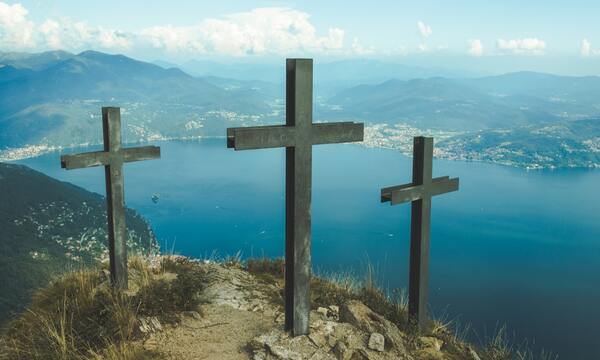This morning, I spent time in Hebrews 12:18-24 during my morning reading in God’s Word.[1] I found myself particularly attuned to some things I had never previously noticed. In the middle of a warning passage — a passage written to caution professing believers not to be passive or turn away from reverent submission to an awesome God — I found my heart and thoughts expanding in wonder, awe and gratitude.
In the first of two paragraphs (vv. 18-21 — full text at the end of this post), we encounter the author of Hebrews drawing upon the most awe-inspiring and truly frightening divine encounter in the history of Israel — the moment when God manifested himself at Mount Sinai in resplendent majesty and thunderously fearsome speech. The author of Hebrews portrays the scene using the following details:
A mountain they were not permitted to touch
A blazing fire
Darkness and gloom
Tempest (or whirlwind)
A trumpet blast
Words so terrifying that the people begged God to stop speaking
Even Moses said, “I tremble with fear.”
Then, with God’s majestic power on full display, the author starts describing something yet more awe-inspiring (is that even possible?). This second scene radiates unsurpassable resplendent glory while starkly contrasting with the dreadful warnings of Sinai. We find ourselves surrounded by a heavenly assembly where the faithful in Jesus belong. It’s more impressive than even Sinai. But whereas Sinai was unapproachable, verses 22-24 describe a place of celebration — awesome, yes — but also accessible. The place seems to be described as up there, but in a real sense, according to this author, we already belong there. Here are some details from Hebrews 12:22-24:
The heavenly city is the perfect archetype of Jerusalem, also referred to as “Mount Zion,” “the city of the living God,” and “the heavenly Jerusalem.”[2]
All around are “myriads of angels in festal gathering.” The author has already introduced the angels in Hebrews 1 & 2, but only to point out that Jesus is better than these powerful heavenly messengers. Here it looks like the author has included angels to highlight the majesty of the scene.
But surprisingly, we’re there, too! We are included along with the entire “church of the first-born who are enrolled in heaven.” We’re not physically there, of course, but since we’re already enrolled in heaven, we belong there. Notice also the description we’re given: “first-born.” Unlike traditional Hebrew inheritance laws where the first-born male got singled out as heir, in this scene we all are called “first-born.”
But there’s more! This scene includes other humans — those who’ve already died, whom the author refers to as “the spirits of righteous men made perfect.” The saints of history are also part of this festal scene!
And, of course, sitting on his glorious throne in the center of it all is “God, the judge of all.” This solemn description of God reminds us that although we can celebrate along with angels and ancient saints, God is the one who will judge the living and the dead. But this raises a question. How can anyone celebrate in the presence of the judge of our eternal destiny? The answer is (for Christians it always has been and always will be)….
Jesus! The author of Hebrews describes Jesus in this scene as “the mediator of a new covenant.” We have access to God and don’t have to fear God’s judgment because of the session and intercession of Jesus. That’s why we can truly experience a sense of belonging in the presence of God even though he is the judge.
But our access isn’t only based on Christ’s mediation, though that is true. Christ’s covenant blood also gives us access. Here this blood is described as “the sprinkled blood that speaks a better word than the blood of Abel.” Whereas Abel’s blood “spoke” a message of judgment and separation from God upon Cain, Christ’s blood invites us into forgiveness and cleansing and access to God.
A heavenly city!
Myriads of angels!
The church!
Saints of old!
God the judge!
Jesus our mediator!
Access through the blood of Christ!
Pause and worship, brothers and sisters. Permit God’s word to move you toward awe, holy reverence, and worship.
The author of Hebrews follows this remarkable celebratory description by warning his readers not to refuse God’s communication: Don’t forget the fearsome scene of Sinai or the festal scene of the heavenly Jerusalem. But today I was taken in by the awe prompted by both scenes — and (as the author of Hebrews exhorts a few verses later, v. 28) found myself drawn toward reverence and worship of the one who thundered on Sinai but now has invited me into celebratory praise in the heavenly Jerusalem.
Full text of Hebrews 12:18-24
Now that you’ve read these reflections, can I suggest that you read this text aloud — reverently and worshipfully?
For you have not come to what may be touched, a blazing fire and darkness and gloom and a tempest and the sound of a trumpet and a voice whose words made the hearers beg that no further messages be spoken to them. For they could not endure the order that was given, “If even a beast touches the mountain, it shall be stoned.” Indeed, so terrifying was the sight that Moses said, “I tremble with fear.”
But you have come to Mount Zion and to the city of the living God, the heavenly Jerusalem, and to innumerable angels in festal gathering, and to the assembly of the firstborn who are enrolled in heaven, and to God, the judge of all, and to the spirits of the righteous made perfect, and to Jesus, the mediator of a new covenant, and to the sprinkled blood that speaks a better word than the blood of Abel.
This and other resources are available at
Notes
[1] That is, the morning of the day I initially wrote this post.
[2] “If the movable tabernacle in the wilderness was constructed according to the pattern of the sanctuary on high, so the temple and city of Jerusalem were material copies of eternal archetypes.” F. F. Bruce, The Epistle to the Hebrews, rev. ed. (Eerdmans, 1990), 356.
 51ÂÜŔň
51ÂÜŔň

.jpg)
.jpg)

.jpg)